The Mute Devil and the Volcanoes of Southern Chile
“Trust in dreams for in them is the hidden gate to eternity.” Kahlil Gibran
Volcan Villarica erupting in 1985
The first time I saw Volcán Villarrica, it was exploding, and torrents of fiery lava were pouring down its slopes. We were busy kayaking the Río Trancura, and the thought of skiing this pristine mountain never even crossed my mind.
Kurt Casey skiing Volcan Villarica
The magnificent rivers of Chile held me in their grasp for many years, and I enjoyed some incredible voyages, but the great mountains kept beckoning, and I finally answered their call.
Volcán Villarrica towers above the trendy tourist village of Pucón, Chile, and climbing the volcano has become one of the most popular pastimes in town. During the warm, summer days, dozens of adventurous tourists put on crampons for the first time in their lives and amble up a well-worn but steep glacial trail to the summit of the lofty volcano. In good conditions, it is an easy climb. But in bad weather, which is very frequent, the throngs of novices on the icy slopes have suffered many accidents and a few deaths, so the authorities managed to convince us that we had to have a guide.
Guiding climbers up the volcano was the biggest gig in town, and the rates were very competitive. But finding someone who would also rent skis — and allow his clients to take off by themselves — took some doing.
“You want to ski the volcano?” the skeptical owner of Sol Y Nieve (Sun and Snow) asked.
Though there was a small ski area on the lower part of the mountain, the idea of summer skiing had not yet arrived in Chile, and he looked at us like we were a bit crazy. But, he didn’t want to turn down business, so he found the key to his ski storage area and rented us the necessary equipment. The skis were somewhat ancient, but they looked reasonable, and he seemed to be the only source in town, so we paid a small deposit and made plans to meet him the next day.
We arrived very early and spent about an hour watching a group of intoxicated Chileans stagger out of a nearby disco while we waited for the bus to arrive.
The first leg of the journey was an old chairlift, which was very exciting. We tried to understand the lift operator, who seemed very nervous and was speaking a language that we did not totally comprehend. But we were able to figure out that, since the loading ramp was void of snow, we had to carry our skis and packs on a very exposed and slow chairlift without safety bars. Disembarking was the greatest challenge of the day — we jumped off of the chair and scrambled to get out of the way. Then we watched a great circus as tourists from all over the world struggled to put on their crampons for the first time.
Our guide had emigrated from Peru and was very experienced. Sergio had climbed many of the peaks in the Cordillera Blanca, but he could make more money on this easy volcano and had scaled it more than a hundred times. He was very fit and was happy to have clients who could keep up with him, so we set a fast pace and passed most of the other tourists.
We enjoyed a pleasant lunch at his favorite spot on the summit and savored a bird’s eye view of the many volcanoes in the Lake District.
“Wow! What’s that?” I asked, pointing to a very large and steep volcano.
“That is Volcán Lanín,” Sergio answered. “It is the king of the valley. It is about 3,000 feet higher than Villarrica and more difficult. It involves about 8,000 vertical feet of climbing and the slope is about 45 degrees at the top. We take two days and camp on the glacier.
“It can also be climbed from Argentina, and they have two huts for the high camps. But I think that it would be very difficult to ski, and the weather is usually bad.”
Llaima was nearly as big and looked a lot friendlier for skiing, and Lonquimay looked incredible. Osorno stood gallantly near the Pacific Ocean, and Choshuenco towered beside a pristine lake.
“Wow! The spring skiing around here looks incredible!” I said enthusiastically, and I immediately started to make future plans.
Our guide looked a bit jealous as we strapped on our skis and sped away, but he wished us luck and said he’d meet us at the bottom.
Villarrica was a very good mountain for skiing. The centuries of flowing lava and cinders had created a nearly perfect cone with some of the best downhill terrain on the planet. The receding glaciers provided a year-round base, as well as a wide variety of gullies, ridges, and open bowls, and up to 5,000 vertical feet of skiing. The sun was shining, and the conditions were perfect, so we took our time and stopped often to enjoy the majestic vistas of the surrounding lakes and mountains.
Sergio and Mary rushed down to meet us, and we celebrated together in the streets of Pucón.
A couple of years later, I managed to convince my friend James Brooks, who was a seasoned ski patroller, into joining me, and we went on a mission to ski these lofty peaks.
The local Chilean skiers told me that October was usually the best month for good weather and corn snow, so we booked a flight to Santiago and started to plan the expedition.
Since we hadn’t skied since June, and some of the volcanoes involved steep terrain, we hoped to tune up our techniques on some lift-serviced slopes. October there is the same as April in the Northern Hemisphere, which meant that the conditions were like spring in the States, and a few of the ski areas were still operating. The web site for a resort called Las Leñas stated that it was still open, so we boarded a bus in Santiago and headed east across the continental divide into Argentina.
The bus ride took us through the middle of Portillo, which had already closed, but a flock of giant condors entertained us as we crossed the high pass. Most of the buses in South America were very comfortable, and the premium buses were like first class on an airplane. The seats were wide and could recline almost all the way, and the wine was complementary, so the miles passed quickly, and we arrived in San Rafael in the late evening. San Rafael was a pleasant village at the edge of the Andes, and the only bus to Las Leñas was in the morning, so we booked a room and enjoyed a huge steak and some great wine in local restaurant.
The bus to Las Leñas was still running, but the web site had been wrong, and the lifts had been closed for a week. Some of the hotels and one restaurant were still open, and the snow pack looked quite good, so we decided to spend a few days exploring the area.
The only restaurant that was still open was called Johnny’s Place and it was filled with a large variety of late-season local workers. This employee hangout featured a cafeteria-style buffet, and the menu included large amounts of beef and potatoes and a pitcher of cheap wine for each table. The peso had recently been devalued, so a three-room condo with all the amenities was only thirty dollars per night.
We awoke early the next morning and started to walk up the barren hill to the visible snow on the higher slopes. We had walked less than 200 yards when a jeep full of jovial workers stopped and offered us a lift. They were working on the mountain and happily gave us a ride to the snow.
The terrain of Las Leñas was incredible, and the backcountry offered a lifetime of adventurous pursuits, so we climbed a small peak, and tested our ski legs on some sun-cupped snow. An exciting day of skiing left us in good spirits, and we wandered back to “Johnny’s Place,” which was filled with the local after work crowd.
The restaurant was hopping, and we tried to practice our Spanish with a diverse group of ski patrollers and trail crew.
“Why do they call this Las Leñas?” James asked a local ski patroller.
“Leñas means trees, and those small bushes are the only things that resemble a tree in this whole area,” he replied.
They invited us to check out their ski-patrol office and showed us the techniques that they used to control avalanches on the steep and exposed terrain.
The snow was melting rapidly, and we were eager to get to the volcanoes, so we boarded another bus and headed south to San Carlos de Bariloche. This small city on the northern edge of Patagonia felt like the South American equivalent of Lake Tahoe, and offered a beautiful lake, access to some incredible mountains, and a wide variety of bars and restaurants.
The ski area was still open, and we enjoyed two days of very good skiing. The mountains above the ski area were still covered with snow, so we climbed a small peak and watched dozens of condors soar above us as we ate our lunch and enjoyed the view.
Four days of skiing had been great for our legs and confidence, and we were only an eight-hour bus ride away from our first volcano, so our excitement level surged as we planned the next leg of our journey.
The day dawned sunny and warm, but the clouds thickened when we crossed the high border, and it was pouring rain when we arrived in Pucón, Chile. Volcán Villarrica was hiding in a cloud, and the forecast predicted three more days of rain, so we headed north to Volcán Chillán, which had somewhat better weather and a small ski area with a hot spring at the bottom.
The area was closed, and most of the people had left for the season, but a friendly hostel welcomed us, and we awoke early to start our first journey. The weather was a bit mixed, but we started climbing anyway and enjoyed a very pleasant afternoon as the skies cleared. The conditions at the summit did not look very appealing, so for our descent, we chose a very pleasant 35-degree face that started near the summit and offered about 3,500 vertical feet of quality skiing that ended at the hot spring.
There was another peak nearby called Nevado Chillán, which I had previously climbed with my friend Bruno. It had a large, 45-degree face and was bigger and farther away, so we packed our gear and planned for an overnight journey.
The weather was changing as we climbed past Volcán Chillán and into a windswept saddle with amazing views. The sunset was one of the best that I have ever experienced, as the alpenglow literally exploded in the blowing snow, and created a spectacular light show. We settled in for a windy and snowy night and awoke to a strong breeze and very bad visibility.
The steep slope had been blanketed by a large accumulation of wind-blown snow during the night and was obviously very dangerous. So we explored the area around the saddle where we had camped and headed back down to the hot spring. The bad visibility and crusty snow, combined with our heavy packs, made the descent quite challenging, and we were very happy to reach the bottom.
“It’s gonna be at least a few days before that peak will be safe to ski, and the weather forecast doesn’t look very good, so maybe we should try something else,” I suggested, as we enjoyed the hot spring.
The social life of Pucón was always tempting, so we headed back and partied with a few old friends while waiting for the weather to improve. James met an adventurous French gal during the break, and she was eager to join us, so we loaded up my friends Datsun pickup and headed off on another adventure.
I had seen Volcán Lonquimay from the Bío-Bío River and had heard that it was a great mountain to ski. It was also adorned with an ancient Araucaria forest. This magnificent tree is supposedly one of the oldest species of plant on the planet, and the thought of skiing through an ancient forest sounded very enticing.
The road to Lonquimay traveled through an old and very long one way tunnel that was also used by a railway. It looked a bit sketchy and was dripping water in many locations, but we made it through and vowed to look for a different route on the return voyage.
The road continued onto the high flanks of the big volcano, and the ancient forest was astounding. It was too late in the day to ski, but we enjoyed a pleasant hike amidst the giant trees. The small village of Lonquimay was nearly vacant, but we found a small cabin to rent and feasted in the style of the rural Chileans.
We awoke to brilliant weather and quickly drove to the ridge that we hoped to ski. The snow was just starting to soften, and we kicked steps up the exposed ridge to the summit, which revealed a large crater and a stunning vista. The slope was about 35 to 40 degrees, but its dome shape made it feel like an ever-steepening drop with no end in sight. This added to the excitement of the run, but the conditions were perfect, and we thoroughly enjoyed the 4,000-vertical-foot descent.
Volcán Llaima had dominated the landscape from Lonquimay, and the skiing looked incredible. The summit was more than 10,000 feet above sea level, and a new ski area had been recently built at 5,000, so it was obvious that a very good day of skiing awaited us.
The main route to Llaima involved following a valley all the way back west to Ruta cinco, heading thirty miles south, then following another valley back east. This strategy would have stretched the direct distance of about forty miles into a journey of about two hundred miles, so we inquired about an apparent shortcut at the local gas station.
We quickly learned that gas station attendants were not the best people to ask for directions in Chile. They made very low wages and were usually uneducated local villagers who rarely traveled out of town. This, combined with our less-than-fluent understanding of the Spanish language was almost certain to cause confusion.
The road that was recommended to us headed south out of Curacautín and seemed to be fairly well travelled. But the conditions quickly deteriorated, and after about ten miles of bouncing along on a primitive track, we arrived at a lonely farmhouse and stopped to ask about the conditions of the road ahead.
“Si, camino esta bien (Yes, the road is good),” remarked a friendly woman, who was very startled to see the Gringos.
The farm had a magnificent view of Volcán Llaima, and we started to drool as we watched the morning sun hit the slopes. We drove onward for another ten miles until the road ended abruptly at a washed-out bridge. “Puente en mal estado (Bridge is in bad condition),” stated the sign, so we turned around and drove back to Ruta Cinco.
It was a long drive, but the weather was great, and we stopped to buy wine and food at a very friendly grocery store in a small rural village. Llaima dominated the landscape, and the alpenglow at sunset was spectacular.
The ski resort of Las Araucarias had recently closed, but the hostel was still open, and the local workers were busy drinking wine and watching a soccer game. The restaurant was still serving food, and we enjoyed a very festive dinner while we tried to converse with our fellow diners. Some of them had climbed the volcano, and they showed us the advised route on a large poster hanging in the hostel.
The main room at the hostel had about thirty beds, but, luckily, we were the only inhabitants, and sleep came very quickly. We awoke at 4 AM with a very high level of energy, but it didn’t take long to realize that the two day window of weather was over and another torrential down pour had moved in.
The weather forecast predicted a week of rain, but we weren’t ready to give up that easily, so we slept in and spent the day exploring a nearby national park with pristine lakes and an ancient forest of giant hardwoods.
The park was empty except for us and it didn’t rain all day, so we managed to sneak in a short hike and enjoyed the songs of many birds. The next day dawned with even harder rain, so we explored some new roads and spent the evening at a pleasant hot spring.
As the forecast continued to look grim, and our allotted time was nearly over, James and his girlfriend decided to explore some new terrain while I visited some friends in Pucón. The rainy conditions were still good enough for kayaking, and I enjoyed a very pleasant day on the Río Liucura with some old and new friends.
The storm eventually waned, and I ventured back to Volcán Villarrica. The weather was excellent, and I managed to convince the authorities that I didn’t need a guide, so I started very early and enjoyed the solitude of an empty mountain. The mood of the volcano changed constantly, and the summit was filled with smoke, but I avoided most of it and spent a leisurely hour gazing at the many lakes and volcanoes in the surrounding valleys. Llaima was still beckoning, but this journey was nearly over, so it would have to wait for another day. Fresh snow from the recent storm provided perfect conditions, and I enjoyed a very casual descent.
A few months later, we decided to try our luck on the shrinking glaciers of northern Peru. I hadn’t climbed there since 1978, but Brad Johnson had recently written a new guidebook to the Cordillera Blanca, and his photos and descriptions were very enticing.
Our goal was to ski from the summit of a 6,000-meter-high peak (about 19,700 feet), and Brad recommended Nevado Copa as a good ski descent, so we packed our bags and boarded another plane. My wife Mary had never experienced a big mountain and was anxious to try, so she decided to join us.
Downtown Huaraz had changed quite a bit in twenty-seven years, and the mountains had become a lot more crowded. But the air was still clean, and the locals were very friendly.
Nevado Ishinca sounded like a good peak to climb as a warm up and to get acclimated. The summit was just over 18,000 feet high, and it would have been the highest point from which we had ever skied. But since the glacier had receded to about 16,000 feet, the ski run would be very short.
The Peruvian transportation had improved a bit since the late 1970s, and it was very easy to find a taxi that would take us to the trailhead. We found the burros waiting, and a pleasant hike through a very scenic valley brought us to the base camp at 14,300 feet.
The night air was cold, but some Italian climbers had constructed a hut, so we spent a pleasant evening next to a warm stove eating lasagna. The sky was clear, and as we wandered back to our tents, we enjoyed the grand spectacle of the bright stars hovering above the high peaks.
We wanted to give our bodies some time to adapt to the high altitude, so we spent a leisurely day in the majestic valley surrounded by large mountains. The views of Tocllaraju were stunning and left us pondering future expeditions.
The weather in the Cordillera Blanca was usually very good, and we awoke to another brilliant day. The burro trail ended at the base camp, so we reluctantly loaded our heavy packs and trudged up to Laguna Ishinca. The trail was steep and long, and the packs were heavy, but we finally reached the high camp, where we enjoyed a brilliant sunset and a very starry night.
Sleep was difficult at the high altitude, so we watched the stars and awoke well before the dawn. The trail through the moraine was actually quite easy, and we arrived at the glacier just as the first rays of sunlight glistened off of the high peaks. The early morning air was cold, but the sky was clear, and we wandered slowly up the glacier.
“I’m not feeling very good!” Mary said, suddenly sitting down to take a break.
Machu Picchu is an incredible place and an important part of any visit to Peru, but serious climbers are advised to wait until they have finished their expeditions before pursuing other tourist activities. The chance of catching intestinal bugs is high in Peru, and the odds increase with the number of restaurants that you sample.
We had gone there first to avoid the crowds, but Mary had contracted an intestinal bug, and the high altitude was complicating the situation.
The short break helped her to reenergize, but the sun was up and the glacial ice was softening very rapidly. A close encounter with a crevasse convinced us that we were moving much too slowly, and we decided to change our plans. A nearby high saddle offered a stunning vista, so we took a short lunch break, then left our skis there before heading back to camp. The lightened loads would make the next day’s ascent a lot faster.
The perfect weather held, and we started very early the next morning. Mary was feeling better, but she decided to stay at camp, and James and I moved rapidly with the light packs. We arrived at the summit early and enjoyed another great view of the surrounding peaks. Ishinca was a fairly easy climb, but the summit pyramid involved a hundred yards of 45-degree slope on a very exposed ridge.
The snow was quite severely sun-cupped and did not look like a good warm up ski run, so I opted to leave my skis a bit lower down. I watched anxiously as James carefully attached his bindings and prepared for the steep descent. The first turn was a bit rough, but he managed to keep his balance and avoid the hazardous cliff on his left. The next turn was better, and his confidence grew as he smoothly negotiated the steep slope. The rest of the glacier was about 35 degrees, and we enjoyed excellent corn conditions all the way back down to the lake.
Skiing from the top of a high mountain is a wonderful thrill, and it has become one of my favorite pastimes. The climb alone is often well worth the effort, but that few extra pounds of gear allows the climber to enjoy a very exciting and rapid descent.
James and I arrived at camp in a very exuberant state, and almost immediately, we started to plan our next adventure.
The Cordillera Blanca is very close to the equator and the rapidly receding glaciers have left some very challenging glacial moraines in their place. These treacherous slopes are filled with thousands of unstable boulders, and have become the crux of many Peruvian climbs. Nevado Copa fit in this category, and a half mile of stumbling over unstable terrain with heavy packs convinced us that we could find better ways to spend our time.
Plan B was a superb ten day trek in the pristine Cordillera Huayhuash. This amazing range of mountains was inhabited by the infamous Shining Path rebels for many years, and a few violent encounters with the primitive locals had managed to scare most of the tourists away.
We decided to hire a cook and a local burro driver and experienced some of the best mountain vistas in the world. Our trip was climaxed by an enjoyable ascent of a 17,500 foot peak called Diablo Mudo (The Mute Devil).
The route involved a bit of loose rock with some exciting 45 degree snow, and was very similar to Pyramid Peak in Colorado with a small glacier on top. The summit offered an amazing vista of the high peaks, and we celebrated with a “Pancha Mama asado.”
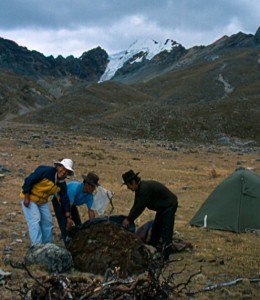
Our Cook prepared a Pancha Mama (Barbecued Lamb) to celebrate our ascent. Mute Devil is in the background.
The mountains of Peru are truly magnificent and they offer some of the best alpine routes in the world, and the great canyons are even better, but if skiing is the main objective, the volcanoes of southern Chile are a much better choice.


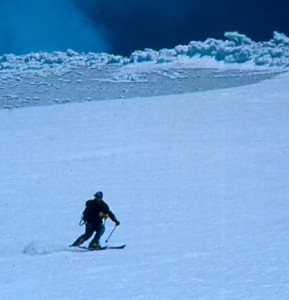
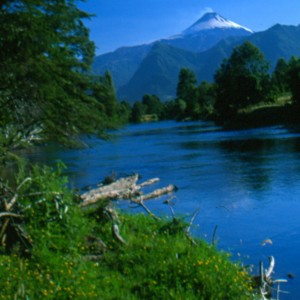

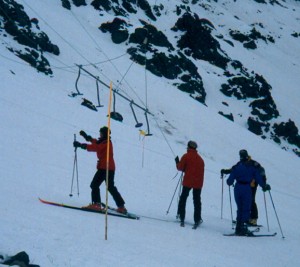
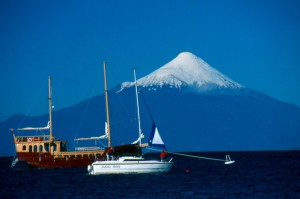

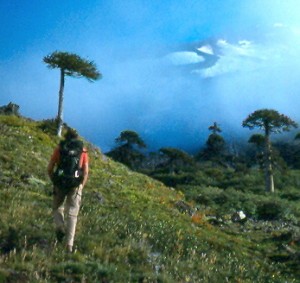
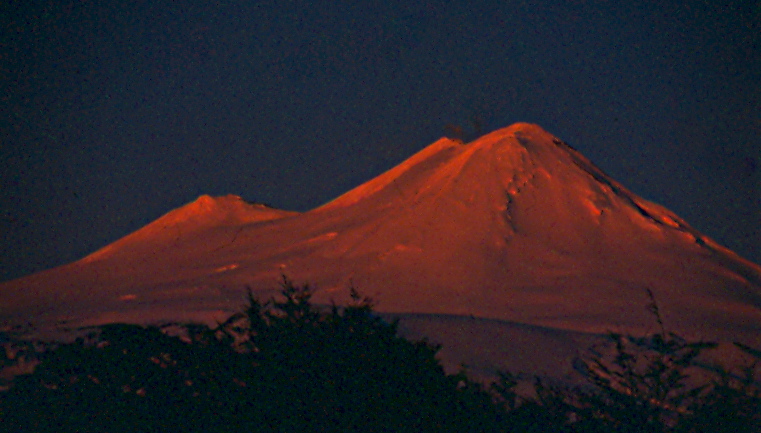
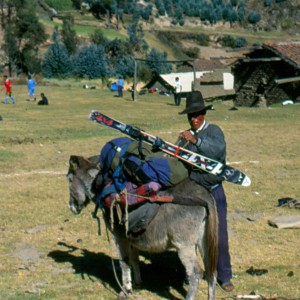
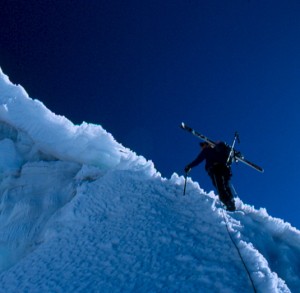
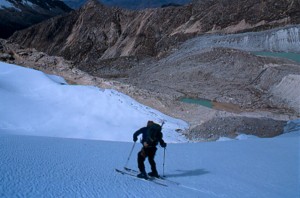
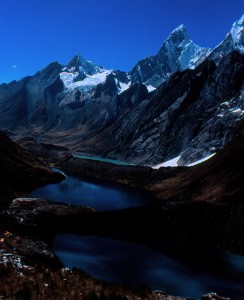
ONE THOUGHT ON “THE MUTE DEVIL AND THE VOLCANOES OF SOUTHERN CHILE”